Simulations
This expects that your variables are simple values or JSON-objects/ -arrays.
For now this only works for Camunda 7.
Simulations let you run BPMNs and DMNs automatically on an installed Camunda 7 Platform. The diagrams must be deployed.
For the deployment I created a script that also starts the Simulation.
See deploy.
Why
I like Simulations because:
- If there are problems, you easily can check the Camunda Cockpit.
- I think they are easy to maintain.
- The in- and outputs are exactly the API of the BPMNs.
- You can move to every part of your BPMN automatically, for example to check a UserTask.
- It is great to develop test driven.
- With the heat map, you can check, if you tested already all paths.
Of course most of these points are also true for Unit- and/or Scenario tests.
I also experimented with Unit- and Scenario Tests, and it would also be possible. But for now I concentrate my time on Simulations. I also think you should only do one of them, due to the work involved.
Get Started
Simulations use the BPMNs you created - in this context I refer to the Bpmn DSL
Let's start with a basic example:
// put your simulations in the simulation package of your project (it)
package camundala.examples.invoice.simulation
// import the projects bpmns (Processes, UserTasks etc.)
import camundala.examples.invoice.bpmn.*
// define a class that extends from a simulation DSL
class InvoiceSimulation extends CompanySimulation:
simulate(
// add scenarios (comma separated)
scenario(`Review Invoice`)(
AssignReviewerUT,
ReviewInvoiceUT
),
scenario(InvoiceAssignApproverDMN),
incidentScenario(
`Invoice Receipt that fails`,
"Could not archive invoice..."
)(
ApproveInvoiceUT,
PrepareBankTransferUT
),
// more scenarios ..
)
end InvoiceSimulationThis class is automatically created with ./helper.scala process <processName> - see development > process.
simulate
This is the entry point for your Simulation. There is one Simulation per Simulation class (file). A Simulation contains one or more Scenarios.
scenario
A scenario consists of a BPMN process or a DMN decision. Then in optional second brackets you can add steps that interact with the process. For DMNs there won't be any.
Run the Simulation
In your sbt-console:
-
run all simulations:
simulation/test -
run some simulations:
simulation/testOnly *MySimulationYou can use any pattern, where
*is wildcard for any characters.
This creates the following output:
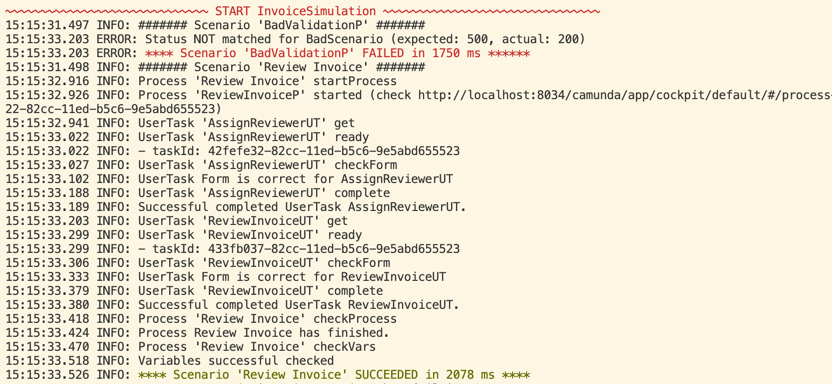 ...
...
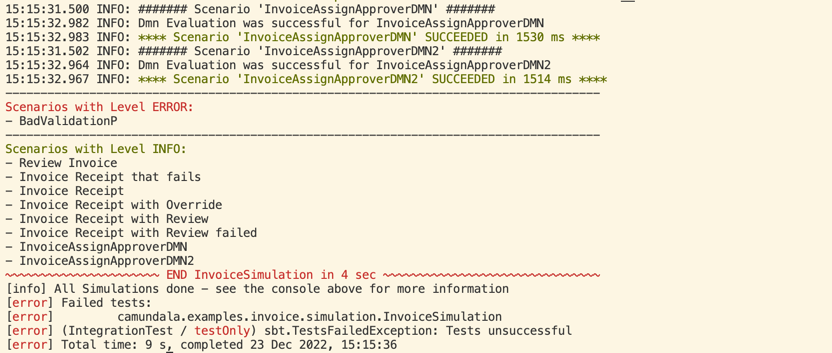
Log Levels Colors
Depending on the log level, the most important delimiters are in color:
- Error: Red
- Warning: Magenta
- Info: Green
Simulation succeed / failure
As soon as there is a log entry with the level ERROR, the Simulations fail and the failing Simulations are listed.
Reference to Camunda Cockpit
Each Process Scenario will print a link to the according Process-Instance:
15:15:32.926 INFO: Process 'example-invoice-c7-review' started (check http://localhost:8034/camunda/app/cockpit/default/#/process-instance/42f84722-82cc-11ed-b5c6-9e5abd655523)
This is not available for a DMN Scenario.
Simulation
Naming
The DSL is using the names of your BPMN objects like Processes and UserTasks. As these objects can be reused in different Scenarios and Steps, we take the name of the variable.
lazy val `Invoice Receipt with Review` =
`Invoice Receipt`
.withOut(InvoiceReceiptCheck(clarified = Some(true)))
lazy val NotApproveInvoiceUT =
ApproveInvoiceUT
.withOut(ApproveInvoice(false))
.
..
scenario(`Invoice Receipt with Review`)(
NotApproveInvoiceUT,
subProcess(`Review Invoice`)(
AssignReviewerUT,
ReviewInvoiceUT // do clarify
),
ApproveInvoiceUT, // now approve
PrepareBankTransferUT
)
...In this example we have a ProcessScenario with the name Invoice Receipt with Review. The first Step has the name NotApproveInvoiceUT.
Use descriptive variable names. If you use special characters, you need to use backticks, like:
lazy val `Invoice Receipt with Review` =
...These names are then used in the output Log:

Configuration
The configuration is described in 03-simulation.
You can easily override it in your Simulation:
override implicit def config =
super.config
.withLogLevel(LogLevel.DEBUG)
.withMaxCount(20)Especially interesting on the level of each Simulation are:
logLevelto debug the Simulation.maxCountto increase the timeout for the interactions (one count is one second).
Scenarios
The following chapters explain the different scenario types:
Process Scenarios
scenario
An end to end simulation of one process path.
...
scenario(PROCESS)
scenario(PROCESS)(
INTERACTIONS
)
...- PROCESS: The Process you defined with the BPMN DSL.
- INTERACTIONS: Whenever the Path of the Process comes to an Activity that interacts with the outside world (User Task, Receive Message Event or Receive Signal Event), you add an according Process Step - see Steps. This is optional, you can skip it if your process has no interactions.
Example:
...
scenario(`Invoice Receipt with Review`)(
NotApproveInvoiceUT,
subProcess(`Review Invoice`)(
AssignReviewerUT,
ReviewInvoiceUT // do clarify
),
ApproveInvoiceUT, // now approve
PrepareBankTransferUT
)
...incidentScenario
To simulate a process that stops due an incident needs a special treatment as it never finishes.
...
incidentScenario(
PROCESS,
INCIDENT_MESSAGE
)
incidentScenario(
PROCESS,
INCIDENT_MESSAGE
)(
INTERACTIONS
)
...Additional to the scenario we need to define:
- INCIDENT_MESSAGE: This is the incident message or a part of it.
Example:
...
incidentScenario(
`Invoice Receipt that fails`,
"Could not archive invoice..."
)(
ApproveInvoiceUT,
PrepareBankTransferUT
)
...badScenario
Yet another case is if the process never gets started. For example you validate the input variables and they fail. In this case Camunda throws an Error. To handle this we need to do the following:
...
badScenario(
PROCESS,
HTTP_STATUS,
ERROR_MESSAGE
)
...- HTTP_STATUS: The status of the REST response.
- ERROR_MESSAGE: Optional you can define the message or part of it, that the body must contain.
Example:
...
badScenario(
BadValidationP,
500,
"Validation Error: Input is not valid: DecodingFailure(Missing required field, List(DownField(creditor)))"
)
...DMN Scenario
Camundala uses the Evaluate Decision REST API from Camunda.
simulate(
scenario(InvoiceAssignApproverDMN)
)
// OR
simulate(
InvoiceAssignApproverDMN // scenario is created automatically
)As this is a single request, all you need is to add your DMN description you did with the BPMN DSL.
See Business Rule Tasks (Decision DMNs)
The simulation does the following steps:
- Take the attributes from your input
- Call the evaluation service
- Validate the result with your output
The Example:
We have the following DMN definition (bpmn):
lazy val InvoiceAssignApproverDMN = collectEntries(
decisionDefinitionKey = "example-invoice-c7-assignApprover",
in = SelectApproverGroup(),
out = Seq(ApproverGroup.management),
descr = "Decision Table on who must approve the Invoice.",
)This uses the following Inputs and outputs (domain):
case class SelectApproverGroup(
amount: Double = 30.0,
invoiceCategory: InvoiceCategory =
InvoiceCategory.`Software License Costs`
)
@description("These Groups can approve the invoice.")
enum ApproverGroup:
case accounting
, sales
, management- Running this will use the inputs
amountandinvoiceCategoryfor the evaluation. - The result, a list of
ApproverGroups (collectEntries), will then be matched against our specifiedApproverGroups.
At time of writing, there is no replacement in Camunda 8 for this.
Start Scenario with message
It is also possible to send a message to a process with a Start Message Event.
...
scenario(PROCESS.startWithMsg)
scenario(PROCESS.startWithMsg)(
INTERACTIONS
)
...All that is needed is to postfix the process with .startWithMsg.
Ignore a Scenario
You can ignore a scenario by just prefix your Scenario with ignore.
Examples:
simulate(
ignore.scenario(`Review Invoice`)(
AssignReviewerUT,
ReviewInvoiceUT
),
ignore.incidentScenario(
`Invoice Receipt that fails`,
"Could not archive invoice..."
)(
ApproveInvoiceUT,
PrepareBankTransferUT
),
ignore.scenario(InvoiceAssignApproverDMN),
ignore.badScenario(
BadValidationP,
500,
"Validation Error: Input is not valid: DecodingFailure(Missing required field, List(DownField(creditor)))"
),
)An ignored Scenario will create a Warning in the output Log, like this:
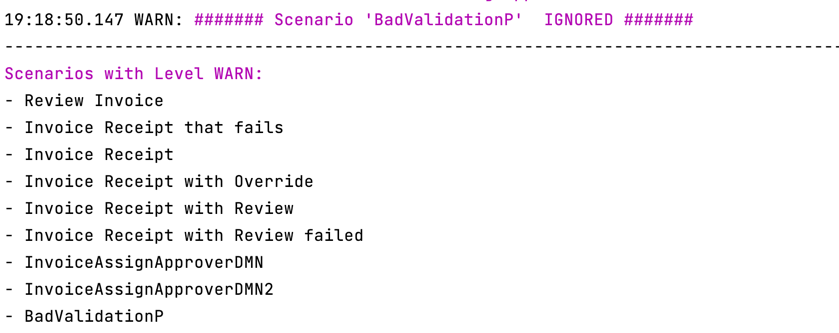
Ignore all Scenarios
If you want to ignore all the Scenarios you can 'ignore' the Simulation like:
ignore.simulate(
scenario(.
..),
scenario(
...),
)Only a Scenario
You can run only one are a few scenario at the time by just prefix your Scenarios with only.
Examples:
simulate(
scenario(`Review Invoice`)(
AssignReviewerUT,
ReviewInvoiceUT
),
only.incidentScenario(
`Invoice Receipt that fails`,
"Could not archive invoice..."
)(
ApproveInvoiceUT,
PrepareBankTransferUT
),
only.scenario(InvoiceAssignApproverDMN)
)An only Scenario will create a Warning for all other Scenarios as they are ignored.
Steps
This is a List with Process Interactions like User Task, Receive Message Event or Receive Signal Event. Each Interaction is simply the Activity you define with the BPMN DSL.
...
scenario(PROCESS)(
STEP1,
STEP2,
...
)
...See example in Process Scenarios.
Sub Process (Call Activity)
A special case are sub processes. If your process contains sub processes, there are the following possibilities:
-
The sub process has no interactions:
- Nothing to do.
-
The sub process contains interactions, but is mocked (returns a defined result, skipping the interactions):
- Nothing to do.
-
The sub process contains interactions:
-
You can add a subProcess to your simulation, like:
... subProcess(`Review Invoice`)( AssignReviewerUT, ReviewInvoiceUT // do clarify ), ...This will change the context to the sub process and in the end switch it back to the main process.
-
You can add a subProcess to your simulation, like:
This only works for one hierarchy of sub processes. When you have more complex sub processes, you must mock them.
Not recommended: please test each process separately.
Validation
The simulation uses your BPMN DSL objects not just to run the process and its interactions. It also uses the input- and output domain objects to validate variables of the process.
// domain classes
case class In(
creditor: String = "Great Pizza for Everyone Inc.",
amount: Double = 300.0,
//...
)
case class Out(
approved: Boolean = true,
//...
)
//...
// bpmn object
process(
in = InvoiceReceipt(),
out = InvoiceReviewed()
)- in: The input of a BPMN object.
- out: The output of a BPMN object.
Each attribute of the in/out-objects represents a variable on the process.
The exact usage of the BPMN DSL objects differ slightly:
Process
- in: Each attribute is an input variable to start the process.
- out: When process is finished it validates if these attributes match the according variables in the process.
User Task
- in: When the process is at the User Task, it validates if these attributes match the according variables in the process.
- out: Each attribute is a variable to complete the User Task.
Receive Message Event
- in: Each attribute is a variable to send a message to start or proceed the process.
Receive Signal Event
- in: Each attribute is a variable to send a signal to start or proceed the process.
Test Overrides
There may be lots of variables to test or you first just want to develop the process. In this case you can override the validation with the domain objects.
...
scenario(WithOverrideScenario)(
`ApproveInvoiceUT with Override`,
PrepareBankTransferUT
)
...
private lazy val WithOverrideScenario =
`Invoice Receipt with Override`
.exists("approved")
.notExists("clarified")
.isEquals("approved", true)
private lazy val `ApproveInvoiceUT with Override` =
ApproveInvoiceUT
.exists("amount")
.notExists("amounts")
.isEquals("amount", 300.0)As you see in this example, you can simply add checks. Now only these checks are run by the validation.
The following overrides are provided (for now):
exists
.exists(VARIABLE_NAME)A variable with this VARIABLE_NAME must exists.
notExists
.notExists(VARIABLE_NAME)A variable with this VARIABLE_NAME must not exists.
isEquals
.isEquals(VARIABLE_NAME, VARIABLE_VALUE)A variable with this VARIABLE_NAME must have the value VARIABLE_VALUE.
hasSize
For collections:
.hasSize(VARIABLE_NAME, VARIABLE_VALUE_SIZE)A variable with this VARIABLE_NAME must be a collection with the size VARIABLE_VALUE_SIZE.
For DMN ResultList and CollectEntries:
.hasSize(VARIABLE_VALUE_SIZE)A DMNs result must be a collection with the size VARIABLE_VALUE_SIZE.
contains
For collections:
.contains(VARIABLE_NAME, VARIABLE_VALUE)A variable with this VARIABLE_NAME must be a collection and one of its values must have the VARIABLE_VALUE.
For DMN ResultList and CollectEntries:
.contains(VARIABLE_VALUE)A DMNs result must be a collection and one of its values must have the VARIABLE_VALUE.
Read the Results
During execution and checking the results some of the results are printed on the console. The most important stuff is then gathered during the Simulation and printed grouped by the Simulation and Scenario.
The reason that there are some logs during execution, is that we used Gatling earlier. So the core still is not migrated to the new Simulation, that gathers all the logs and prints it nicely at the end.
Simulations Overview
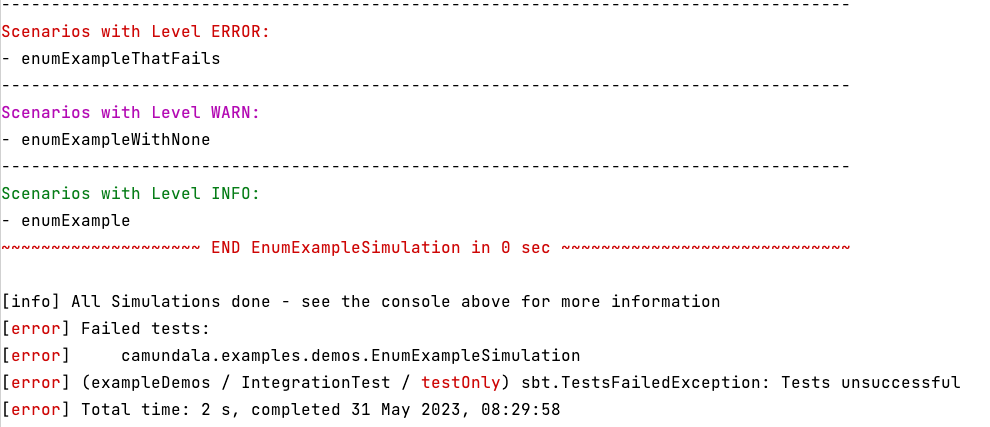
- First you see all Scenarios grouped by its LogLevel.
- Failed Simulations are listed at the end.
If you run more than one Simulation (sbt It/test), each Simulation is printed with the Scenario overview.
At the end all Simulation that failed are listed.
Scenarios Overview

- Each Scenario is started with a marker in the color of its log level.
- According to the configured Log Level all messages are printed.
- You have a link to the process in the Camunda Cockpit.
- If the Validation failed, you need to look for
!!!in the above log. See the next chapters. - It ends with a marker that shows the time the Scenario took.
Result is different
The expected value does not match the value of the process.
Example:
!!! The expected value 'CString(hello,String)' of someOut does not match the result variable 'CString(other,String)'.
List(CamundaProperty(.., CamundaProperty(simpleEnum,CString(One,String)), CamundaProperty(someValue,CString(hello,String)), ...))It always lists all Variables of the Process below the message.
Result is missing
This is for optional variables, where you expect a value, but in the process there is no such variable.
Example:
!!! The expected value 'CString(hello,String)' of someOut does not match the result variable 'CNull'.
List(CamundaProperty(.., CamundaProperty(simpleEnum,CString(One,String)), CamundaProperty(someValue,CString(hello,String)), ...))Result is not expected
This is for optional variables you have set to None, but in the process such a variable exists.
Example:
!!! The expected value 'CNull' of someOut does not match the result variable 'CString(hello,String)'.
List(CamundaProperty(.., CamundaProperty(simpleEnum,CString(One,String)), CamundaProperty(someValue,CString(hello,String)), ...))Timing
The interactions with a process are time relevant. For example you only can interact with a User Task if the process is actually at that User Task.
For this we check every second if the process is ready.
The time on how long it should check can be configured. See maxCount in Configuration.
Whenever this timeout is reached, it throws an exception and the scenario has failed.
Here an example output:

Depending on the interaction, we have the following strategies:
Process
To check the variables of a process, the process must be finished.
It checks if the state of the process is COMPLETED.
User Task
It simple tries until there is a User Task in the process available. If there are more than one, it just takes the first one.
To complete a User Task, you can also wait some seconds. This is useful, if you want to check if intermediate events were triggered.
scenario(userTaskExampleProcess)(
userTaskExample
.waitForSec(2) // wait 2 seconds
)Receive Message Event
We try to correlate the message until it is successful.
This works as Camunda tries to correlate a message to exactly one
Receive Message Event (we use the processInstanceId).
Receive Signal Event
The way of Correlate Messages does not work for Signals, as they are fire and forget. So you need to add an attribute with a certain value, we can check.
scenario(signalExampleProcess)(
signalExample
.waitFor("signalReady", true),
)Just add the postfix .waitFor(WAITFOR_VARIABLE_NAME, WAITFOR_VARIABLE_VALUE) to the BPMN Signal definition.
In your process you must now set this variable with the according value, when the process is at this event.
This is also possible for Receive Message Event.
If you do not define it for Receive Signal Event it takes the default
value waitForSignal and checks if it is true.
Timer Event
You can execute an intermediate timer event immediately.
scenario(timerExampleProcess)(
timerExample
.waitFor("timerReady", true),
)Concrete wait time
If you have a use case that is easier to just wait a bit (not recommended;), you can just add this step
scenario(signalExampleProcess)(
waitFor(2),
nextUserTask,
)This will wait for 2 seconds.
Mocking
Mocking is handled directly in the processes itself.
This is especially useful in Simulations.
However, you can mock on any environment, like local or production (e.g. with Postman).
See also General Concerns.
Generic Mocking
Running a Process you have 2 possibilities to mock ServiceTasks, CustomTasks, Sub Processes (Call Activities) in a generic way:
-
servicesMocked:-
Mocks all ServiceTasks in a Process.
-
This is a flag you can set to
true,falseis the default.
-
Example:
example .mockServices
-
mockedWorkers: - Mocks all specified Sub Processes and Workers in a Process. - This is a list of processNames and/or topicNames you want to mock. - Example:scala example .mockWorkers(ModuleGlobal.processName, MyWorker.topicName)
For both you need to add an in-mapping in case of a Sub Process (CallActivity).
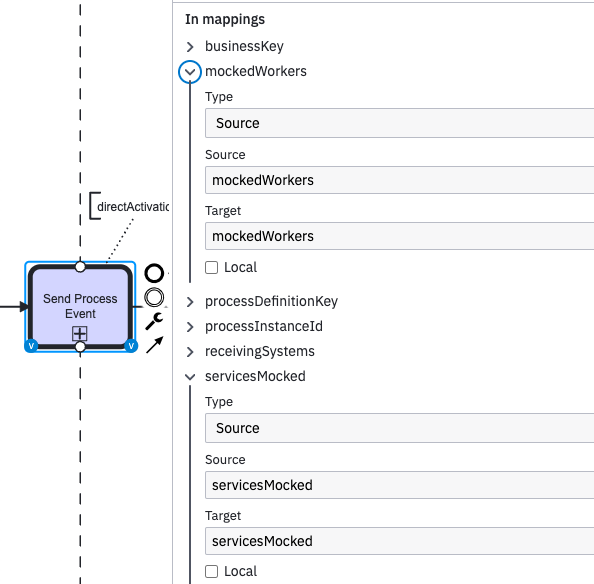
Provide default Mocks
Process or CustomWorker
In your Process or CustomWorker you define automatically a default Mock, with
lazy val example = process(
In(),
Out()
)This is static and will always return Out().
You can also define a dynamic Mock, that depends on the input:
lazy val example = process(
In(),
Out.DoIt()
).mockWith: in =>
if in.doIt then Out.DoIt() else Out.DontDoIt() Here you can create the Mock depending on the input.
Service Worker
Analog to Process or CustomWorker you define automatically a default Mock for ServiceWorker, with
lazy val example = serviceTask(
In(),
Out(),
serviceMock,
serviceInExample
)This is static and will always return serviceMock.toServiceResponse.
You can also define a dynamic Mock, that depends on the input:
lazy val example = serviceTask(
In(),
Out(),
serviceMock,
serviceInExample
).mockWith: in =>
MockedServiceResponse.success200(Out(
if in.value == 1 then true else false
))Here you can create the MockedServiceResponse depending on the input.
Specific Mocking in the Process
It is also possible to define a concrete Mock for a step in the process (Sub Process, Worker).
SubProcess or Worker
You can define the outputMock for any SubProcess or Worker in your InConfig class.
case class InConfig(
...
@description(serviceOrProcessMockDescr(GetPoa.Out()))
getPoasMock: Option[GetPoa.Out] = None,
@description(serviceOrProcessMockDescr(GetPoaPoaKey.Out()))
getPoaDetailMock: Option[GetPoaPoaKey.Out] = None,
@description(serviceOrProcessMockDescr(GetClientClientKey.Out.privateIndividual()))
getPoaPersonMock: Option[GetClientClientKey.Out] = None
)As you see, you just define the Out type of that service.
To provide a nice description, just use @description(serviceOrProcessMockDescr(MyService.Out())).
In your Simulation you can then use this Mock:
example
.withIn(
In(
inConfig =
Some(InConfig(
getPoaPersonMock = Some(GetClientClientKey.Out(
...
)),
))
))ServiceWorker
Additionally, to outputMock, you can define outputServiceMock for any ServiceWorker in your InConfig class.
case class InConfig(
...
@description(serviceOrProcessMockDescr(GetUserToken.serviceMock))
hasAuthMethodOfflineMock: Option[MockedServiceResponse[GetUserToken.ServiceOut]] = None
)As you see, you just define the ServiceOut type of that service wrapped in a MockedServiceResponse.
To provide a nice description, just use @description(serviceOrProcessMockDescr(MyService.serviceMock)).
In your Simulation you can then use this Mock:
example
.withIn(
In(
inConfig =
Some(InConfig(
hasAuthMethodOfflineMock = Some(
MockedServiceResponse.success200(ServiceOut(
UserTokenData(..)
))
))
))
)With outputMock and outputServiceMock, you need an according mapping in the BPMN.

Priorities / Order
There is a defined priority on how the Mocks are applied (from top).
- outputServiceMock (Service Worker only)
- outputMock
- mockedWorkers
- servicesMocked (Service Worker only)
So in general you can override a generic Mock with a specific Mock.
Load Testing
At the moment this is not supported.
As the simulations are run in parallel, you can add more scenarios to increase the load.